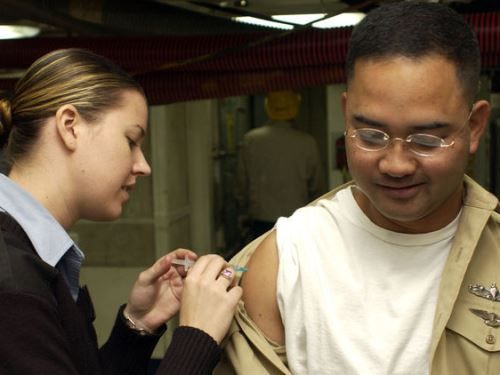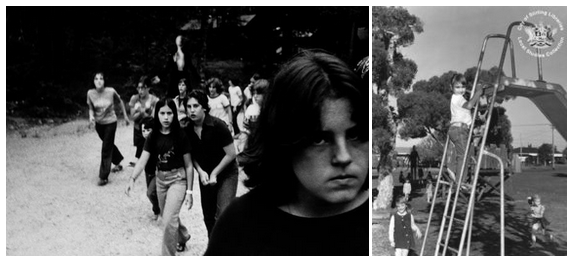Autism
Murder by Meme: Slender Man and the Wakefield Anti-Vax Hoax
Like Slender Man, the vaccine-autism link spread from a single human's fiction.
Posted August 29, 2014
Imaginary roots cannot grow a real tree. A hoax, no matter how popular, remains a hoax. Like scary Slender Man, viral viewpoints over a vaccine-autism link spread from a single human's fiction. After Eric Knudsen created the Slender Man, its myth spread as meme, a malleable open-source horror that inspired a murder attempt. After Andrew Wakefield falsified a vaccine-autism link, it panicked many into campaigning against vaccination.
As part of a photo editing challenge on the Something Awful forums in June of 2009, Eric Knudsen (a.k.a. "Victor Surge") added a thin spectral figure in a black suit to the backgrounds of two black and white photos of groups of children. By adding text to accompany each, he elevated these images into stories - e.g., "One of two recovered photographs from the Stirling City Library blaze. Notable for being taken the day which fourteen children vanished and for what is referred to as 'The Slender Man'. Deformities cited as film defects by officials. Fire at library occurred one week later. Actual photograph confiscated as evidence. 1986, photographer: Mary Thomas, missing since June 13th, 1986."
Other people shared these images and soon began adding their own original Slender Man inventions through stories, videos, and art. The Slender Man, lacking any official canon, mutates as each storyteller reproduces parts the legend and raises a new member of the Slender Man idea population, an open-source horror that spreads as freely as ancient myths and folk tales of yore but at the speed of our modern electronic communications. Unleashed upon the web, this character's story has grown into a larger mythos, and thus spreads the Slender Man, "the Internet meme that proves our need to believe."
This year, two 12-year-old girls were charged as adults for the attempted first-degree homicide of a classmate, also a 12-year-old girl, allegedly stabbing her 19 times in their attempt to kill her in order to please the Slender Man and become his acolytes. For months, police say, the girls plotted to commit murder as the Slender Man's "proxies" to prove themselves worthy to him and to make skeptics see that he really exists.
Once upon a time, Andrew Wakefield created another fiction that took a life of its own and arguably takes human lives. Funded by a lawsuit-chasing law firm that wanted evidence to use as ammunition in order to sue vaccine manufacturers, Wakefield falsied data regarding 12 autistic children, already too tiny a sample upon which to base such broad generalizations and with no controls, in order to link the measles, mumps, and rubella (MMR) vaccine to a "new syndrome" of autism and bowel disease. An ensuing anti-vaccine scare went viral, spreading even as critics questioned the study, other researchers were unable to replicate his results, co-authors separated themselves from Wakefield, evidence mounted that the research had been fraudulent, and the General Medical Council conducted a "fitness to practise panel," its lengthiest ever. The British medical council barred Wakefield from practicing medicine. He lost his licence. 12 years passed between his report's original journal publiation and when the original journal that published the article finally printed a retraction, Its editors noted that “it was utterly clear, without any ambiguity at all, that the statements in the paper were utterly false,” and yet the MMR vaccine's reputation suffered nonetheless. Even though it was Wakefield's hoax, his "elaborate fraud," that started the anti-vax meme, it carried on.

Any meme, a term shortened from the Greek for "imitated thing," is an abstract concept that spreads between people. It is an information pattern that gets copied from person to person, mutating and evolving along the way much like a living creature or species. The discipline of memetics examines how thought content can spread through means analogous to a Darwinian evolutionary model. “Examples of memes are tunes, ideas, catch-phrases, clothes fashions, ways of making pots or of building arches. Just as genes propagate themselves in the gene pool by leaping from body to body via sperms or eggs, so memes propagate themselves in the meme pool by leaping from brain to brain via a process which, in the broad sense, can be called imitation," wrote Richard Dawkins when he first proposed the concept of the meme itself in 1976's The Selfish Gene. Heylighen and Chielens elaborated, "Thus, cultural traits can be seen as analogous to mind viruses (Dawkins, 1993; Brodie, 1996), idea viruses (Godin, 2002) or thought contagions (Lynch, 1996), which are reproduced from mind to mind via imitation or communication." In current vernacular, a meme goes viral.
A meme's validity can be irrelevant to its dispersal. Truth is not its life's blood.
Andrew Wakefield told The Observer that he had no regrets for making his claim that vaccines cause autism. In the Waukesha case, one of the girls charged with stabbing her classmate reportedly told police, "It's weird that I didn't feel any remorse."
Slender Man creator Eric Knudsen, on the other hand, said in a statement to the media, "I am deeply saddened by the tragedy in Wisconsin and my heart goes out to the families of those affected by this terrible act." Eric Knudsen has a conscience. Eric Knudsen did nothing wrong, no more than your great-grandfather should be fined for your speeding tickets.
Related Posts:
- Spectacular Tragedy in a Just World: The Power of "Why?"
- Why Stick to a PTSD Diagnosis Based on Lies by Jodi Arias?
- Aurora Judge Rules "Truth Serum" Can Test Suspect's Sanity




